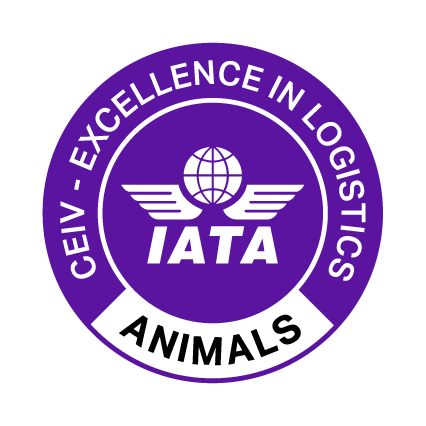Ensure safe, healthy and humane travel for animals

Transporting animals by air is considered to be the most humane and expedient method of transportation over long distances. However, the ensure the safety and welfare of animals, avoiding additional stress, injury and even death, organizations seeking to specialize in this type of air transportation will need to respect very specific requirements.
The Center of Excellence for Independent Validators (CEIV) for Live Animal Logistics establishes baseline standards to improve the level of competency, infrastructure and quality management in the handling and transportation of live animals throughout the supply chain. It is based on the provisions of IATA's Live Animals Regulations (LAR), which is recognized by respected bodies like the World Organisation for Animal Health (WOAH), the Convention on International Trade in Endangered Species of Wild Fauna and Flora (CITES), the US Fish and Wildlife Service (USFWS), and the member states of the European Union, as the benchmark guidelines for the carriage of live animals by air.
Ready to get started? 
Show you're specialists with CEIV Live Animals
- Gain competitive advantage as a high-performing player in the supply chain - CEIV Live Animals provides your partners with assurance of the reliability of your services and your compliance with regulations.
- Be a champion of animal welfare - By becoming certified CEIV Live Animals, your organization is contributing to standardizing the handling and transportation of live animals in the most safe and humane ways, and improving collaboration among stakeholders, for the benefit of your animal passengers.
- Be at the forefront of an emerging sector - The certification process includes training of your employees to handle live animals safely and efficiently, raising professionalism in the industry and ensuring compliance with the stringent regulations pertaining to live animal handling and transport.
Learn more about the benefits of the CEIV Live Animals Program:
Master the entire process
The CEIV Live Animals certification assesses your organization based on the checklist in Appendix I of the Guidelines for CEIV for Live Animals Logistics of the IATA Live Animals Regulations (LAR), and covers the following critical areas of live animal handling operations:
- Quality Management - Including organization and management, your Quality Management System, management reviews, key performance indicators, and risk management.
- Personnel - Including who is responsible, and how staff are trained.
- Training - Including how you ensure compliance with the latest regulations.
- Documentation - And more specifically, documentation relating to processes, operations, and infrastructure and equipment.
- Infrastructure and equipment - Including your premisees, Unit Load Devices (ULDs), monitoring live animals, and your IT systems.
- Deviations and complaints- Including how you manage and track cases.
- Supplier management - Including how you ensure your suppliers meet the same standards.
- Self-inspections - Including the references and tools you use.
- Transportation - Including road and air transport.
- Operations as a whole - Including ground transportation, acceptance of shipments, temporary storage, warehousing, tarmac transportation, aircraft loading and unloading, and live animal facilities.
- Illegal wildlife trade - Including your processes and procedures.
Be supported every step of your CEIV Live Animals journey
The IATA Certification process is designed to guide and support you to success. We give you the understanding, tools and expert advice you need to achieve your organization's certification. The process is as follows:
- Training - At least two (2) key staff must pass the Live Animals Cargo Logistics Management course.
- Assessment - During a period of three (3) to four (4) days, the assessor will visit the facilities to observe that the current operations, processes and procedures of the organization are conducted along the same lines as described in the various documents provided by the organization, and that they conform to the CEIV Live Animals audit checklist requirements. The assessor uses a standardized assessment checklist and criteria to ensure uniformity and objectivity. The assessor will then provide comprehensive feedback, including a gap analysis report and a detailed list of the specific findings and areas of improvement, to enable your organization to make the necessary adjustments.
- Validation - The assessor works in close cooperation with your organization to ensure that all feedback is actioned. Your organization will need to provide a corrective action plan (CAP) specifying the actions you have taken and that are planned, together with an implementation date. The CAP is validated by the assessor as meeting CEIV Live Animals certification criteria. As your organization executes its plan, you must submit clear evidence of its full implementation to the IATA assessor for validation. Once the CAP has been satisfactorily implemented, the assessor will issue the IATA Assessment Report, and your organization will be granted the IATA Certification.
- Re-certification - To maintain your CEIV Live Animals certification, your key personnel will need to complete refresher training, and a new assessment will be carried out to check compliance with the certification requirements and continuous improvement.
Talk to a certification expert today to find out how we can help you ensure you're up to standard.
Note: IATA Certification does not handle the IATA accreditation program. If you are a travel agent or cargo agent, please visit the customer portal to get support regarding accreditation services and training.